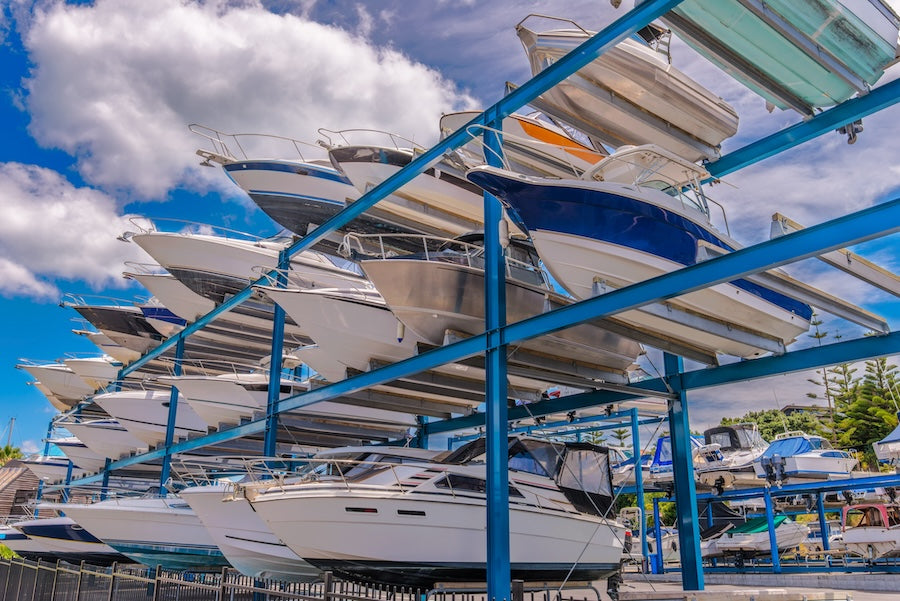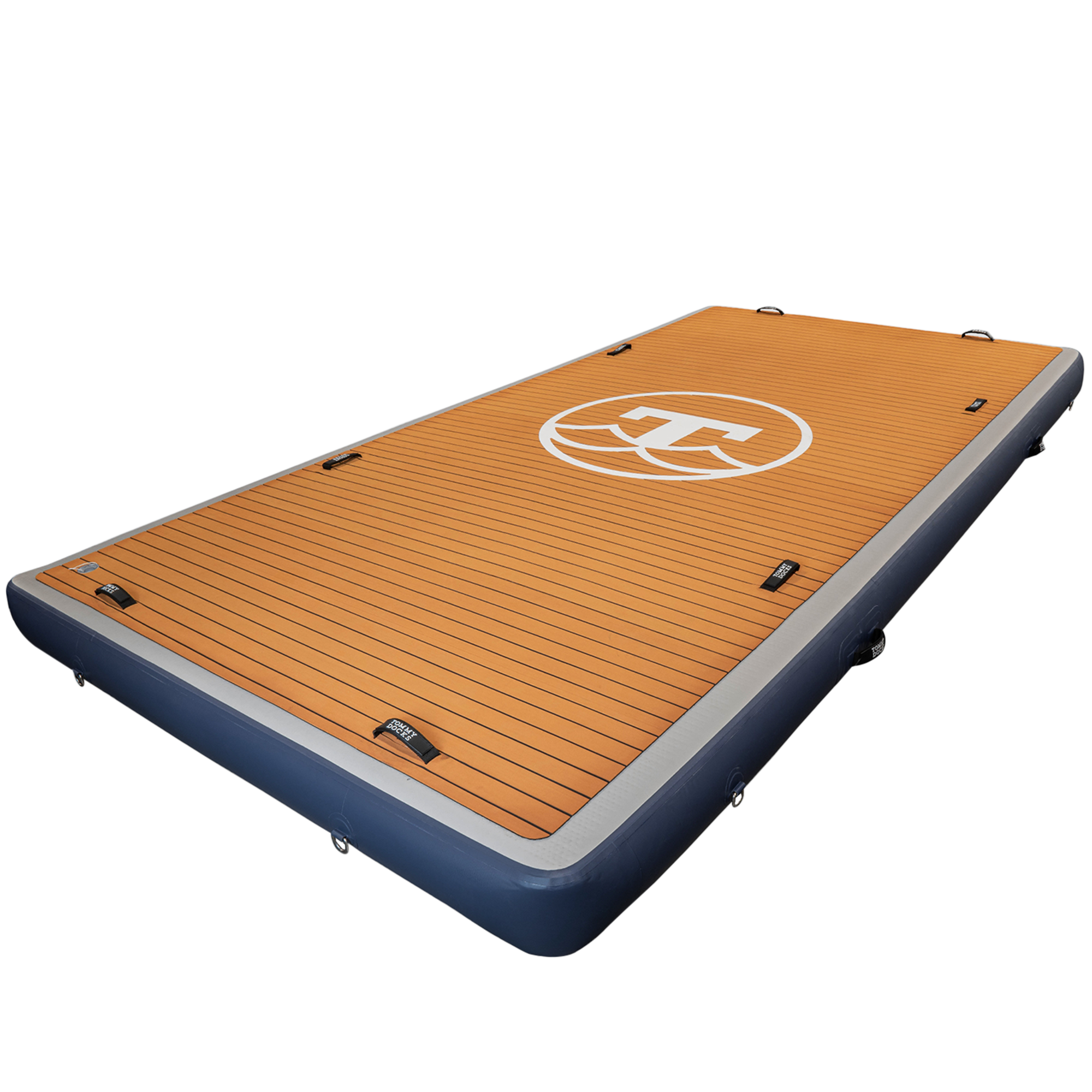Jet skis, boats, and other personal watercraft (PWCs) offer some of the best ways to enjoy life on the water. But like any valuable vessel, they need proper maintenance and storage to stay in top shape. Dry docking plays a vital role in overall boat care, helping to prevent hull damage, corrosion, and mechanical wear. In this post, we’ll break down three practical dry storage options, including the innovative system from Tommy Docks, to help you choose the best setup for your boat or jet ski. We’ll also cover essential boat storage and winterization tips to protect your investment when it’s out of the water.

Why Dry Storing Your PWC or Boat is Optimal
Before diving into the options, let's understand why dry storing your boat or PWC is useful:
-
Prevents Hull Damage: Continuous water exposure can damage the hull, affecting your PWC's or boat’s integrity and performance.
-
Reduces Corrosion and Wear: Freshwater or saltwater, both can corrode metal parts and degrade seals and gaskets over time.
-
Discourages Algal and Barnacle Growth: Dry boat storage keeps the hull clean and free from marine organisms.
-
Enhances Security: On-land storage facilities are less prone to theft or vandalism.
-
Saves on Maintenance Costs: A well-maintained PWC or boat stored dry will have lower repair and upkeep costs.
-
Protects Against the Elements: Outdoor storage exposes boats to rain, snow, and UV rays, while indoor storage provides a dry place and climate protection.
Boat storage isn’t only about finding a spot to park; it’s about choosing a setup that matches your vessel’s size, length, and usage frequency. From a small jet ski to a cabin cruiser, every boat benefits from proper long-term storage planning.

1. The Innovative PWC Ramp from Tommy Docks
Tommy Docks' PWC ramp is a standout solution for jet ski enthusiasts seeking a simple and efficient dry docking option. This prefab dock accessory is designed for ease of use, with wheels that allow you to effortlessly roll your jet ski up from the water onto the ramp. Its durable construction ensures it can withstand repeated use and harsh winter weather, making it a reliable choice.
Additionally, the ramp's design is space-efficient, occupying minimal shoreline storage area. This versatility makes it suitable for a wide range of PWC and small boat models, offering a convenient and practical solution for dry storage. For boat owners with limited shoreline access or slip holders at a marina, a PWC ramp can double as short-term storage between outings, especially during the busy summer months.
2. Floating Boat and Jet Ski Docks
Floating docks are a favorite among both boat and PWC owners, offering a convenient, low-maintenance way to store watercraft safely above the waterline. They’re easy to install, customizable, and adaptable to your setup.
Because they rise and fall with changing water levels, floating docks are especially useful on lakes, rivers, or coastal areas where conditions fluctuate. Their design provides gentle support to the hull, helping to prevent scratches, dents, and moisture-related wear. Floating docks also create a stable, walkable platform, making it easier to board, clean, or perform light maintenance on your boat or jet ski.
While the upfront cost can be higher than a basic shoreline ramp, the long-term value and convenience are hard to beat. For households or marinas managing several types of watercraft, floating docks can be expanded or reconfigured as storage needs evolve. Many marinas even integrate floating systems into their dry stack facilities to simplify launching and retrieval throughout the boating season.

3. Boat and Jet Ski Lifts
Boat and jet ski lifts are an ideal choice for anyone seeking a more permanent, secure storage solution on the water. These mechanical systems raise your vessel completely above the surface, protecting it from constant exposure, wave action, and corrosive elements that can lead to premature wear.
Boat lifts are especially useful in areas with strong currents, tides, or frequent boat traffic, keeping your vessel steady and dry when not in use. They also provide a convenient, stable platform for cleaning, inspections, or maintenance—whether you’re working on a small jet ski or a larger fishing or pontoon boat.
The tradeoff is that boat and jet ski lifts tend to be more expensive and complex to install than simpler options like ramps or floating docks. They also take slightly longer to operate. However, for long-term boaters who value performance, appearance, and protection, a lift offers an effective way to preserve the life of your watercraft.
General Boat Storage Options and Preparation Tips
Beyond PWCs, larger boats require thoughtful planning to handle long-term or winter storage. Whether you store at home, in a marina, or at a professional storage facility, preparation is key.
Common Boat Storage Options
-
Indoor Boat Storage: Keeping your boat in an enclosed garage, storage unit, or professional indoor storage facility offers the best protection against winter weather and the elements. This option prevents UV damage, paint fading, and moisture buildup.
-
Outdoor Boat Storage: Outdoor storage lots or boat yards are ideal for larger vessels or those seeking budget-friendly options. While storage fees may be lower, always use a heavy-duty tarp or shrink wrap to keep water and debris away.
-
Dry Stack Facility: A dry stack facility stores multiple boats in racks, protecting them from water damage while conserving space. These setups often include forklifts to move boats in and out, offering convenience during the boating season.
-
Marina Storage: Many marinas provide slip holders with access to long-term or winter storage packages. These often include maintenance services, security, and easy launching during the application period or when summer returns.

Preparing Your Boat for Winter Storage
Proper winterization prevents costly repairs and ensures your boat is ready to hit the water again when the warmer months return. Here’s a quick checklist:
-
Clean Thoroughly: Remove dirt, algae, and salt residue from your boat’s hull and deck.
-
Drain All Water Systems: This includes bilge, ballast, and plumbing systems to prevent freezing.
-
Apply Protective Coatings: Wax or polish metal surfaces to prevent corrosion during long-term storage.
-
Remove Electronics and Valuables: Store them in a dry place indoors.
-
Cover Securely: Use a heavy-duty tarp, custom-fit cover, or shrink wrap to shield your boat from snow, rain, and UV damage during storage
-
Check Ventilation: Proper airflow helps prevent mold and mildew during the winter months.
-
Inspect the Battery: Disconnect and store it in a climate-controlled storage area.
Regular maintenance before and after the winter season helps extend your vessel’s life and avoid unexpected springtime repairs.
Long-Term Storage Considerations
Long-term storage requires a little more planning than simply parking your boat for a few weeks. Boat owners should consider factors like the storage rack’s weight capacity, the total length of their boat, and accessibility during off-season hours.
If you’re storing your boat on your property:
-
Ensure the storage area is level and has proper drainage.
-
Use wheel chocks for trailers to prevent rolling.
-
Keep the boat covered with a breathable tarp to avoid condensation buildup.
If storing at a storage facility or marina:
-
Ask about their storage fees, security systems, and access hours.
-
Verify if the facility offers indoor boat storage or dry stack options for added protection.
-
Confirm insurance coverage for potential damage during storms or winter weather.
Many occasional boaters prefer dry boat storage for its convenience, while year-round enthusiasts may invest in a lift system for easy launching during the summer months.
Storing PVC Boats and Other Small Watercraft
PVC boats, inflatables, and small dinghies also need proper storage care. Avoid leaving these in outdoor storage under direct sunlight for long periods, as UV rays can weaken the material. When preparing for winter storage, clean and dry the boat completely, deflate it partially to reduce stress on seams, and store it in a dry place such as a storage locker or garage.
If using a tarp, avoid sealing it too tightly; ventilation is essential to prevent moisture buildup.
Factors to Consider When Choosing a Dry Dock or Storage Solution
When deciding how to store your boat or PWC, the right choice depends on your vessel type, local climate, and budget. Here’s a simple guide to help you decide what’s best for your situation:
-
Water Conditions:
-
If you dock in calm, protected waters, a floating lift or covered slip is usually sufficient year-round.
-
For rough, tidal, or open-water areas, consider a dry dock or high-and-dry rack system to keep your boat safe from waves and shifting water levels.
-
Space and Accessibility:
-
Limited yard or marina space? Go for stacked dry storage (rack storage) to maximize room.
-
If you want frequent access, a drive-up outdoor lot or covered carport-style storage offers easier in-and-out convenience.
-
Budget:
-
Outdoor storage is the most affordable but offers less protection.
-
Covered or indoor storage costs more but helps preserve paint, upholstery, and electronics.
-
For high-value boats, climate-controlled indoor storage is worth the investment to minimize long-term maintenance costs.
-
Maintenance Requirements:
-
Boats stored outdoors may need more frequent cleaning and waxing due to sun and weather exposure.
-
Indoor or shrink-wrapped storage minimizes upkeep but may require dehumidifiers or ventilation to prevent mildew.
-
Climate:
-
In mild climates, outdoor covered storage or shrink wrapping may be enough.
-
In harsh winter areas where water freezes, full indoor storage or removal from the water is essential to prevent hull and engine damage.
By weighing these factors, you can match your storage method to your boat’s size, local weather, and usage habits, ensuring it stays protected and ready for the next season.
Storing Your PWC and Boat Safely With Tommy Docks
Choosing the right dry storage for your jet ski, PWC or boat is important for the longevity of your watercraft. At Tommy Docks, we provide a variety of different solutions, including our easy-to-use PWC ramp, floating docks & more. If you own a larger boat, dry stack storage or an indoor storage unit is a good option, especially if you live in an area with harsh winters, since it provides a higher level of protection against the elements.
By considering factors like water conditions, space, budget, and maintenance, you can make an informed decision that suits your needs and ensures many more years of enjoyable and safe boating. No matter if you're an occasional boater or a seasoned sailor, choosing the right solution for boat storage is just as important as selecting the boat itself.
At Tommy Docks, we offer a wide range of reliable, easy-to-use solutions for both occasional boaters and seasoned slip holders who prioritize convenience and performance. From our versatile floating and stationary docks to our high-quality dock accessories, we have everything you need to enhance your boating experience. Whether it’s a PWC ramp or dock-mounted accessories, our products provide secure and efficient storage options. Remember, investing in the right boat storage system isn’t just about convenience; it’s about protecting your passion for the water, season after season, with quality products designed for durability and performance.






